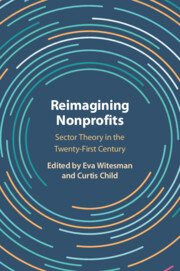Book contents
- Reimagining Nonprofits
- Reimagining Nonprofits
- Copyright page
- Contents
- Figures
- Tables
- Contributors
- Acknowledgments
- 1 An Invitation to Rethink the Nonprofit Sector
- Part I Overviews
- Part II Reflections and Refinements
- Part III New Directions
- 12 Nonprofits as Organizational Actors
- 13 Nonprofits as Enablers of Multilayered Representation
- 14 Nonprofits as Facilitators of National Self-development
- 15 Nonprofits as Part of an Engineered Social Economy
- 16 Nonprofits as Shaped by the Ruling Party
- 17 Nonprofits as Sources of Authoritarian Regime Stability
- 18 Nonprofits as Creators of Transformative Symbolic Reality
- 19 Nonprofits as Distributors of Toll Goods
- 20 Nonprofits as Agents of Moral Authority
- Part IV Conclusion
- Index
- References
17 - Nonprofits as Sources of Authoritarian Regime Stability
from Part III - New Directions
Published online by Cambridge University Press: 11 January 2024
- Reimagining Nonprofits
- Reimagining Nonprofits
- Copyright page
- Contents
- Figures
- Tables
- Contributors
- Acknowledgments
- 1 An Invitation to Rethink the Nonprofit Sector
- Part I Overviews
- Part II Reflections and Refinements
- Part III New Directions
- 12 Nonprofits as Organizational Actors
- 13 Nonprofits as Enablers of Multilayered Representation
- 14 Nonprofits as Facilitators of National Self-development
- 15 Nonprofits as Part of an Engineered Social Economy
- 16 Nonprofits as Shaped by the Ruling Party
- 17 Nonprofits as Sources of Authoritarian Regime Stability
- 18 Nonprofits as Creators of Transformative Symbolic Reality
- 19 Nonprofits as Distributors of Toll Goods
- 20 Nonprofits as Agents of Moral Authority
- Part IV Conclusion
- Index
- References
Summary
This chapter discloses the functions of the nonprofit sector in non-Western democratic national contexts and argues that a state’s political regime is related to the hierarchy of functions performed by the nonprofit sector in that state. The authors focus on the function of legitimacy and the ways the nonprofit sector performs it in a non-democratic context, with Russia as an example. They construct a theoretical model that explains why nonprofits instead of other organizations fulfill certain functions in nondemocratic regimes. The chapter concludes with a discussion on the model’s relevance to other nondemocratic contexts.
Keywords
- Type
- Chapter
- Information
- Reimagining NonprofitsSector Theory in the Twenty-First Century, pp. 333 - 352Publisher: Cambridge University PressPrint publication year: 2024
References
- 1
- Cited by

